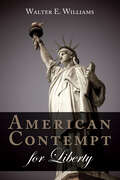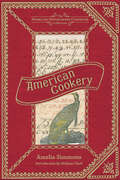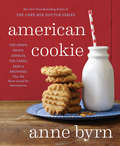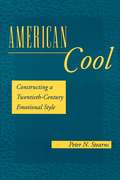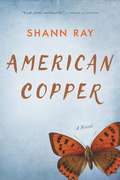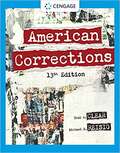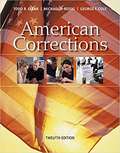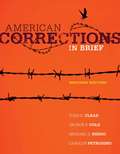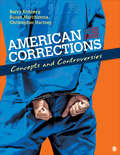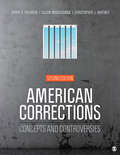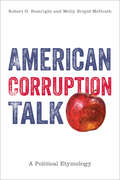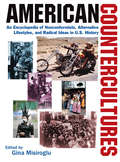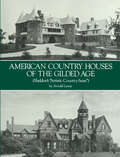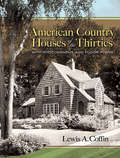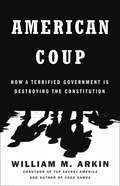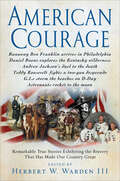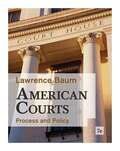- Table View
- List View
American Contagions: Epidemics and the Law from Smallpox to COVID-19
by John Fabian WittA concise history of how American law has shaped—and been shaped by—the experience of contagion“Contrarians and the civic-minded alike will find Witt’s legal survey a fascinating resource”—Kirkus, starred review “Professor Witt’s book is an original and thoughtful contribution to the interdisciplinary study of disease and American law. Although he covers the broad sweep of the American experience of epidemics from yellow fever to COVID-19, he is especially timely in his exploration of the legal background to the current disaster of the American response to the coronavirus. A thought-provoking, readable, and important work.”—Frank Snowden, author of Epidemics and Society From yellow fever to smallpox to polio to AIDS to COVID-19, epidemics have prompted Americans to make choices and answer questions about their basic values and their laws. In five concise chapters, historian John Fabian Witt traces the legal history of epidemics, showing how infectious disease has both shaped, and been shaped by, the law. Arguing that throughout American history legal approaches to public health have been liberal for some communities and authoritarian for others, Witt shows us how history’s answers to the major questions brought up by previous epidemics help shape our answers today: What is the relationship between individual liberty and the common good? What is the role of the federal government, and what is the role of the states? Will long-standing traditions of government and law give way to the social imperatives of an epidemic? Will we let the inequities of our mixed tradition continue?
American Contempt for Liberty
by Walter E. WilliamsThroughout history, personal liberty, free markets, and peaceable, voluntary exchanges have been roundly denounced by tyrants and often greeted with suspicion by the general public. Unfortunately, Americans have increasingly accepted the tyrannical ideas of reduced private property rights and reduced rights to profits, and have become enamored with restrictions on personal liberty and control by government. In this latest collection of essays selected from his syndicated newspaper columns, Walter E. Williams takes on a range of controversial issues surrounding race, education, the environment, the Constitution, health care, foreign policy, and more. Skewering the self-righteous and self-important forces throughout society, he makes the case for what he calls the "the moral superiority of personal liberty and its main ingredient—limited government." With his usual straightforward insights and honesty, Williams reveals the loss of liberty in nearly every important aspect of our lives, the massive decline in our values, and the moral tragedy that has befallen Americans today: our belief that it is acceptable for the government to forcibly use one American to serve the purposes of another.
American Cookery (American Antiquarian Cookbook Collection)
by Amelia SimmonsThis eighteenth century kitchen reference is the first cookbook published in the U.S. with recipes using local ingredients for American cooks. Named by the Library of Congress as one of the eighty-eight “Books That Shaped America,” American Cookery was the first cookbook by an American author published in the United States. Until its publication, cookbooks used by American colonists were British. As author Amelia Simmons states, the recipes here were “adapted to this country,” reflecting the fact that American cooks had learned to prepare meals using ingredients found in North America. This cookbook reveals the rich variety of food colonial Americans used, their tastes, cooking and eating habits, and even their rich, down-to-earth language.Bringing together English cooking methods with truly American products, American Cookery contains the first known printed recipes substituting American maize for English oats; the recipe for Johnny Cake is the first printed version using cornmeal; and there is also the first known recipe for turkey. Another innovation was Simmons’s use of pearlash—a staple in colonial households as a leavening agent in dough, which eventually led to the development of modern baking powders. A culinary classic, American Cookery is a landmark in the history of American cooking. “Thus, twenty years after the political upheaval of the American Revolution of 1776, a second revolution—a culinary revolution—occurred with the publication of a cookbook by an American for Americans.” —Jan Longone, curator of American Culinary History, University of MichiganThis facsimile edition of Amelia Simmons's American Cookery was reproduced by permission from the volume in the collection of the American Antiquarian Society, Worcester, Massachusetts, founded in 1812.
American Cookery: The First American Cookbook (American Antiquarian Cookbook Collection)
by Amelia SimmonsThis eighteenth century kitchen reference is the first cookbook published in the U.S. with recipes using local ingredients for American cooks. Named by the Library of Congress as one of the eighty-eight “Books That Shaped America,” American Cookery was the first cookbook by an American author published in the United States. Until its publication, cookbooks used by American colonists were British. As author Amelia Simmons states, the recipes here were “adapted to this country,” reflecting the fact that American cooks had learned to prepare meals using ingredients found in North America. This cookbook reveals the rich variety of food colonial Americans used, their tastes, cooking and eating habits, and even their rich, down-to-earth language.Bringing together English cooking methods with truly American products, American Cookery contains the first known printed recipes substituting American maize for English oats; the recipe for Johnny Cake is the first printed version using cornmeal; and there is also the first known recipe for turkey. Another innovation was Simmons’s use of pearlash—a staple in colonial households as a leavening agent in dough, which eventually led to the development of modern baking powders. A culinary classic, American Cookery is a landmark in the history of American cooking. “Thus, twenty years after the political upheaval of the American Revolution of 1776, a second revolution—a culinary revolution—occurred with the publication of a cookbook by an American for Americans.” —Jan Longone, curator of American Culinary History, University of MichiganThis facsimile edition of Amelia Simmons's American Cookery was reproduced by permission from the volume in the collection of the American Antiquarian Society, Worcester, Massachusetts, founded in 1812.
American Cookie: The Snaps, Drops, Jumbles, Tea Cakes, Bars & Brownies That We Have Loved for Generations
by Anne ByrnFrom the beloved author of the bestselling Cake Mix Doctor series and American Cake comes a delicious tour of America’s favorite treats, cookies, and candies. Each of America’s little bites—cookies, candies, wafers, brittles—tells a big story, and each speaks volumes about what was going on in America when the recipes were created. In American Cookie, the New York Times bestselling author and Cake Mix Doctor Anne Byrn takes you on a journey through America’s baking history. And just like she did in American Cake, she provides an incredibly detailed historical background alongside each recipe. Because the little bites we love are more than just baked goods—they’re representations of different times in our history.Early colonists brought sugar cookies, Italian fig cookies, African benne wafers, and German gingerbread cookies. Each of the 100 recipes, from Katharine Hepburn Brownies and Democratic Tea Cakes to saltwater taffy and peanut brittle, comes with a lesson that’s both informative and enchanting.
American Cool: Constructing a Twentieth-Century Emotional Style
by Peter N. StearnsCool. The concept has distinctly American qualities and it permeates almost every aspect of contemporary American culture. From Kool cigarettes and the Peanuts cartoon's Joe Cool to West Side Story (Keep cool, boy.) and urban slang (Be cool. Chill out.), the idea of cool, in its many manifestations, has seized a central place in our vocabulary. Where did this preoccupation with cool come from? How was Victorian culture, seemingly so ensconced, replaced with the current emotional status quo? From whence came American Cool? These are the questions Peter Stearns seeks to answer in this timely and engaging volume. American Cool focuses extensively on the transition decades, from the erosion of Victorianism in the 1920s to the solidification of a cool culture in the 1960s. Beyond describing the characteristics of the new directions and how they altered or amended earlier standards, the book seeks to explain why the change occurred. It then assesses some of the outcomes and longer-range consequences of this transformation.
American Cool: Constructing a Twentieth-Century Emotional Style (History Of Emotions Ser.)
by Peter N. StearnsCool. The concept has distinctly American qualities and it permeates almost every aspect of contemporary American culture. From Kool cigarettes and the Peanuts cartoon's Joe Cool to West Side Story (Keep cool, boy.) and urban slang (Be cool. Chill out.), the idea of cool, in its many manifestations, has seized a central place in our vocabulary. Where did this preoccupation with cool come from? How was Victorian culture, seemingly so ensconced, replaced with the current emotional status quo? From whence came American Cool? These are the questions Peter Stearns seeks to answer in this timely and engaging volume. American Cool focuses extensively on the transition decades, from the erosion of Victorianism in the 1920s to the solidification of a cool culture in the 1960s. Beyond describing the characteristics of the new directions and how they altered or amended earlier standards, the book seeks to explain why the change occured. It then assesses some of the outcomes and longer-range consequences of this transformation.
American Copper
by Shann RayAs Evelynne Lowry, the daughter of a copper baron, comes of age in early 20th century Montana, the lives of horses dovetail with the lives of people and her own quest for womanhood becomes inextricably intertwined with the future of two men who face nearly insurmountable losses-a lonely bull rider named Zion from the Montana highline, and a Cheyenne team roper named William Black Kettle, the descendant of peace chiefs.An epic that runs from the Sand Creek Massacre of 1864 to the ore and industry of the 1930s, American Copper is a novel not only about America's hidden desire for regeneration through violence but about the ultimate cost of forgiveness and the demands of atonement. It also explores the genocidal colonization of the Cheyenne, the rise of big copper, and the unrelenting ascent of dominant culture. Evelynne's story is a poignant elegy to horses, cowboys both native and euro-american, the stubbornness of racism, and the entanglements of modern humanity during the first half of the twentieth century. Set against the wide plains and soaring mountainscapes of Montana, this is the American West re-envisioned, imbued with unconditional violence, but also sweet, sweet love.
American Cornball: A Laffopedic Guide to the Formerly Funny
by Christopher MillerAmerican Cornball is Christopher Miller's irresistibly funny illustrated survey of popular humor—the topics that used to make us laugh, from hiccups and henpecked-husbands to outhouses and old maids—and what it tells us about our country yesterday and today.Miller revisits nearly 200 comic staples that have been passed down through our culture for generations, many originating from the vaudeville age. He explores the (often unseemly) contexts from which they arose, why they were funny in their time, and why they eventually lost their appeal. The result is a kind of taxonomy of humor during America's golden age that provides a deeper, more profound look at the prejudices, preoccupations, and peculiarities of a nation polarized between urban and rural, black and white, highborn and lowbrow.As he touches on issues of racism and sexism, cultural stereotypes and violence, Miller reveals how dramatically our moral sensibilities have shifted, most notably in the last few decades. Complete with more than 100 period illustrations, American Cornball is a richly entertaining survey of our shifting comic universe.
American Corrections
by George F. Cole Todd R. Clear Michael D. ReisigLearn more about the dynamics of today's correctional system in the U.S. with the fascinating, current content and balanced approach in Clear/Reisig/Cole's market-leading AMERICAN CORRECTIONS, 13E. <p><p> Engaging discussions, actual cases with familiar names and first-hand insights from those in the system immediately grab your interest, while career overviews point to rewarding opportunities in the field. You examine the latest facts and figures as well as new developments and trends impacting correctional policy and practice in the U.S., such as COVID-19 and the rising use of methamphetamines and opioids. <p><p> The authors provide an unbiased treatment of institutional and community sanctions as this well-rounded introduction examines the U.S. correctional system from the perspectives of both the corrections worker and the accused person. MindTap digital resources are also available with interactive learning tools, video cases and career scenarios that bring content to life.
American Corrections (Mindtap Course List)
by George F. Cole Todd R. Clear Michael D. ReisigExplore the American corrections system from the perspective of both the corrections worker and the accused person in AMERICAN CORRECTIONS, 12th Edition. You'll learn about institutional and community sanctions, aided by high-profile corrections cases taken from recent headlines to reinforce important theories. The authors "tell it like it is" with thought-provoking, unbiased examinations of such topics as assisting felons during the re-entry process, reducing recidivism, the death penalty and surveillance. You'll also get a frontline view of careers in the corrections field.
American Corrections (Tenth Edition)
by George F. Cole Todd R. Clear Michael D. ReisigExplore the American corrections system from the perspective of both the corrections worker and the offender in AMERICAN CORRECTIONS, Tenth Edition. Comprehensive yet not overwhelming, the book covers both institutional and community sanctions, incorporating high-profile corrections cases taken from recent headlines to reinforce important theories. The authors "tell it like it is," offering you thought-provoking, unbiased examinations of such topics as assisting felons during the re-entry process, reducing recidivism, the death penalty, and surveillance. You'll also get a frontline view of careers in the corrections field.
American Corrections In Brief (Second Edition)
by George F. Cole Todd R. Clear Michael D. Reisig Carolyn PetrosinoA condensed, more accessible version of the best-selling corrections book on the market, AMERICAN CORRECTIONS IN BRIEF, 2nd Edition, introduces readers to the dynamics of corrections. Complete with valuable career-based material, insightful guest speakers, illuminating real-world cases, and uniquely even-handed treatment of institutional and community sanctions, the book examines the U.S. correctional system from the perspectives of both the corrections worker and the offender, providing readers with a well-rounded, balanced introduction to corrections.
American Corrections: Concepts and Controversies
by Barry A. Krisberg Susan Marchionna Christopher HartneyAmerican Corrections: Concepts and Controversies, by Barry Krisberg, Susan Marchionna, and Chris Hartney, presents an incisive view of every aspect of corrections (including jails, probation, sentencing, prisons, and parole), prompting students to think critically about the complex issues involved in responding to the current crisis in the U.S. correctional system. Incorporating theory, research, and the most recent available data, the book takes a contemporary and issues-oriented approach as it explores the most interesting and progressive developments in correctional policy and practice. Students will come away with practical knowledge, as well as a framework for thoughtful analysis of a subject that can seem mysterious or impenetrable. In addition, the book covers subjects many corrections texts treat only minimally, including women in corrections, the death penalty, and special populations. Perhaps most importantly, the book offers a point of view on what is plaguing the American correctional system and a realistic look at the solutions that offer real promise.
American Corrections: Concepts and Controversies
by Barry A. Krisberg Susan Marchionna Christopher HartneyAmerican Corrections: Concepts and Controversies, by Barry Krisberg, Susan Marchionna, and Chris Hartney, presents an incisive view of every aspect of corrections (including jails, probation, sentencing, prisons, and parole), prompting students to think critically about the complex issues involved in responding to the current crisis in the U.S. correctional system. Incorporating theory, research, and the most recent available data, the book takes a contemporary and issues-oriented approach as it explores the most interesting and progressive developments in correctional policy and practice. Students will come away with practical knowledge, as well as a framework for thoughtful analysis of a subject that can seem mysterious or impenetrable. In addition, the book covers subjects many corrections texts treat only minimally, including women in corrections, the death penalty, and special populations. Perhaps most importantly, the book offers a point of view on what is plaguing the American correctional system and a realistic look at the solutions that offer real promise.
American Corrections: Concepts and Controversies
by Barry A. Krisberg Susan Marchionna Christopher Hartney"It is a thorough and focused work on American corrections providing a solid opportunity for students to learn not only how the correctional system works but also to understand its ever increasing complexities." —Dorie Astle, Southwestern Oklahoma State University American Corrections, Second Edition offers students a contemporary, issues-oriented introduction that covers every aspect of corrections, prompting students to think critically about complex issues that are affecting the current U.S. correctional system. Incorporating the most recent theory, research, and data available, the Second Edition encourages students to explore the most interesting and progressive developments in correctional policy and practice. Authors Barry A. Krisberg, Susan Marchionna, and Christopher J. Hartney draw from years of professional experience to give students a practical knowledge of corrections, as well as provide a framework for thoughtful analysis into what is plaguing the American correctional system and a realistic exploration of the solutions that could make a difference. SAGE Premium Video Included in the interactive eBook! Corrections News Clips bring extra coverage of current events into the book, connecting brief 2 to 4 minute news clips to core chapter content. Interactive eBook Includes access to SAGE Premium Video and other multimedia tools. SAGE coursepacks FREE! Easily import our quality instructor and student resource content into your school’s learning management system (LMS) and save time. SAGE edge FREE online resources for students that make learning easier.
American Corrections: Concepts and Controversies
by Barry A. Krisberg Susan Marchionna Christopher Hartney"It is a thorough and focused work on American corrections providing a solid opportunity for students to learn not only how the correctional system works but also to understand its ever increasing complexities." —Dorie Astle, Southwestern Oklahoma State University American Corrections, Second Edition offers students a contemporary, issues-oriented introduction that covers every aspect of corrections, prompting students to think critically about complex issues that are affecting the current U.S. correctional system. Incorporating the most recent theory, research, and data available, the Second Edition encourages students to explore the most interesting and progressive developments in correctional policy and practice. Authors Barry A. Krisberg, Susan Marchionna, and Christopher J. Hartney draw from years of professional experience to give students a practical knowledge of corrections, as well as provide a framework for thoughtful analysis into what is plaguing the American correctional system and a realistic exploration of the solutions that could make a difference. SAGE Premium Video Included in the interactive eBook! Corrections News Clips bring extra coverage of current events into the book, connecting brief 2 to 4 minute news clips to core chapter content. Interactive eBook Includes access to SAGE Premium Video and other multimedia tools. SAGE coursepacks FREE! Easily import our quality instructor and student resource content into your school’s learning management system (LMS) and save time. SAGE edge FREE online resources for students that make learning easier.
American Corruption Talk: A Political Etymology
by Robert G. Boatright Molly Brigid McGrathAmericans often worry about political corruption—not only about specific officials misusing their powers, but also more broadly about political, cultural, moral decay or deterioration. Underneath our talk about corruption lie deeper claims and concerns about how we organize our common life. American Corruption Talk presents a study of corruption and corruption talk that seeks to understand those deeper claims and concerns. Robert Boatright and Molly Brigid McGrath focus on the role corruption talk plays in American political discourse. They distinguish between two ways people speak about corruption—corruption talk in the style of a purifier, who wishes to expunge the evil forces or drain the swamp, and corruption talk in the style of the mender, who thinks of managing, replacing, or repairing. American Corruption Talk begins by tracing how the concept of political corruption was developed by philosophers and political thinkers, leading up to its use in the American context, especially in the Progressive Era. It also compares modes of contemporary corruption talk in different areas of public life. In doing so, the authors hope to resolve confusion and partisan disagreements about what corruption is and to discourage the tendency to label actions, events, and ideas that we merely disagree with as corrupt.
American Countercultures: An Encyclopedia of Nonconformists, Alternative Lifestyles, and Radical Ideas in U.S. History
by Gina MisirogluCounterculture, while commonly used to describe youth-oriented movements during the 1960s, refers to any attempt to challenge or change conventional values and practices or the dominant lifestyles of the day. This fascinating three-volume set explores these movements in America from colonial times to the present in colorful detail. "American Countercultures" is the first reference work to examine the impact of countercultural movements on American social history. It highlights the writings, recordings, and visual works produced by these movements to educate, inspire, and incite action in all eras of the nation's history. A-Z entries provide a wealth of information on personalities, places, events, concepts, beliefs, groups, and practices. The set includes numerous illustrations, a topic finder, primary source documents, a bibliography and a filmography, and an index.
American Country Houses of the Gilded Age: (Sheldon's "Artistic Country-Seats") (Dover Architecture)
by A. LewisThe "Gilded Age," the three decades following the Civil War, were years of astounding economic growth. Vast empires in oil, shipping, mining, banking, lumber, transportation, and related industries were formed. It was an era in which fortunes were made and lost quickly, almost easily; a period that encouraged - nearly demanded - the public display of this newly acquired wealth, power, and prestige. It was during these heady, turbulent years that a new type of domestic architecture first appeared on the American landscape. Called the "country seat" or "cottage," these houses were grandiose in scale - imposing facades complemented by manicured gardens, with exceptionally large and impressive reception rooms, halls, parlors, dining rooms, and other public areas. Intended exclusively for the very well-to-do, these buildings were designed by some of the finest and most influential architectural firms in America: McKim, Mead & White; Bruce Price; Peabody & Stearns; Theophilus P. Chandler, Jr.; Lamb & Rich; Wilcox & Johnston; and many others. The first, best, and most exquisite documentation of this surge of architectural creativity was the 1886-87 publication of George William Sheldon's Artistic Country-Seats: Types of Recent American Villa and Cottage Architecture with Instances of Country-Club Houses. It presented exceedingly fine photographs, clearly detailed plans and elevations, as well as Sheldon's own commentary for a total of 97 buildings (93 houses and 4 casinos). Most structures were located in new England and the Middle Atlantic states, and embraced the full spectrum of architectural and artistic expressions. This present volume reproduces all of Sheldon's fascinating and historically important photographs and plans, and adds a new, thoroughly accurate text by Arnold Lewis (Professor of Art, the College of Wooster, Wooster, Ohio) that includes the most useful information supplied by Sheldon and also reports on the present condition of each house or casino, providing analyses of elevations and plans, observations about family life in the 1880s, and brief biographical comments about the clients and architects. Sheldon's photographs connect us with a time and style of living that today increasingly seem more the realm of fiction than fact. Yet, in the pages of this important collection, they are brought fresh to life as they appeared when they were new and times were very different.
American Country Houses of the Thirties: With Photographs and Floor Plans
by Lewis A. CoffinAbout 1912, a renaissance of interest in early American architecture occurred that claimed the attention of a broad cross-section of the culture. It was demonstrated not only by being a popular topic in books and magazines, but also by the public's passion for collecting American antique furniture, and by students and architects traveling through different regions of the nation and photographing the most notable architectural examples. In the 1930s, the classic constructions from this earlier time mingled with the new materials and efficient designs, and the great American country house was born. This treasury showcases some of the finest American country houses produced during that unusually fruitful period. Culled from many of the best architectural firms of the time, the volume includes numerous detailed floor plans, lively sketches, and breathtaking photographs of exteriors and interiors. From simple cottages to functional family homes to sprawling estates, a wide variety of styles is represented. Celebrating the stately form, quiet technique, and balance and simplicity that is at the heart of every well-built American country house, anyone interested in history, art, and architecture will find in this collection an inspiring vision.
American Coup: How a Terrified Government Is Destroying the Constitution
by William M. ArkinA stunning exploration of the subtle erosion of freedom in an age of concocted fear and de facto military authority. When we think of a military coup, the first image that comes to mind is a general, standing at a podium with a flag behind him, declaring the deposing of elected leaders and the institution of martial law.Think again.In AMERICAN COUP, William Arkin reveals the desk-bound takeover of the highest reaches of government by a coterie of "grey men" of the national security establishment. Operating between the lines of the Constitution this powerful and unelected group fights to save the nation from "terror" and weapons of mass destruction while at the same time modifying and undermining the very essence of the country. Many books are written about secrecy, surveillance, and government law-breaking; none so powerfully expose the truth of everyday life in this state of war.
American Courage
by Herbert W. Warden IIIDrawn from firsthand and historical writings, this book gives voice to the pilgrims, founding fathers, revolutionaries, pioneers, '49ers, cowboys, soldiers, pilots, and the many other heroes who have built the nation.
American Courage: Remarkable True Stories Exhibiting the Bravery That Has Made Our Country Great
by W. Herbert Warden III“Readers would have a hard time finding a book more inspiring than American Courage.” — The Sunday Oklahoman
American Courts: Process and Policy
by Lawrence BaumThe highly respected AMERICAN COURTS: PROCESS AND POLICY, by top Courts scholar Lawrence Baum, provides clear descriptions of the courts and the activities of the various courts. The Seventh Edition explains what courts do, how people within them behave, and how they relate to the rest of the political system.

